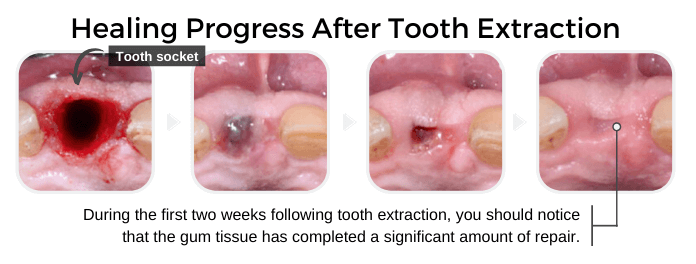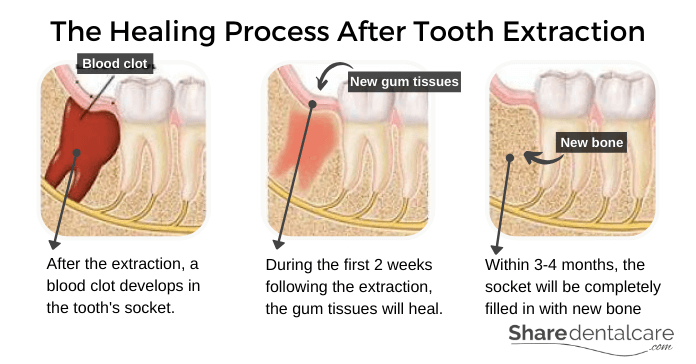
Tooth extraction aftercare is the care you need after the removal of a tooth/teeth to speed up the healing process, minimize the risk of infection, and prevent complications. The initial healing of the extraction site (the socket) usually takes from 1 to 2 weeks, depending on the complexity of the extraction procedure and the size of the wound. For example, surgical or wisdom tooth extraction may take a longer time to heal. The disturbance of the wound during the healing period can lead to painful complications such as a dry socket. So, follow the tooth extraction aftercare instructions to prevent these complications. The aftercare instructions include biting on the gauze pad for 30 minutes, avoiding hot foods and drinks, and taking the prescribed painkillers. You will follow these aftercare instructions for the next few days after the tooth extraction. In this article, we will discuss:
To understand the purpose of tooth extraction aftercare, you should first know how the healing process occurs. Immediately after the extraction of a tooth, the blood fills the extraction site (the socket), and the blood clot begins to form. This blood clot stops the bleeding and protects the underlying bone and nerves. Also, it provides a foundation for the development of a new bone and gum. The disturbance of the blood clot can lead to prolonged bleeding, delayed healing, swelling, and severe pain due to the exposure of the underlying bone and nerves. So, you should follow the tooth extraction aftercare instructions immediately after the removal of a tooth/teeth to speed up the healing process and prevent complications.

The healing time depends on several factors such as the size of the wound, the complexity of the surgery, and the patient’s current status (age, medical condition, and personal habits such as smoking). For example, the surgical extraction of a wisdom tooth usually takes a longer time to heal than the extraction of a lower incisor. During the first 2 weeks following the extraction, the gum tissues will heal and close the wound. After 8 to 10 weeks, two-third of the extraction socket will fill with a new bone. The complete bone healing usually takes from 4 to 6 months.
During the first 48 hours after tooth extraction, these things can disturb the blood clot:

Tooth extraction aftercare begins immediately after the removal of a tooth/teeth. Bite on the gauze pad for 30 minutes and take the prescribed medications. Also, it is important to avoid disturbing the blood clot. We will discuss the tooth extraction aftercare in detail.
The dentist will place a gauze pad on the extraction site. Bite firmly on the gauze pad for 30 minutes to stop the bleeding and don’t keep changing the gauze.

Take painkillers and anti-inflammatory drugs as prescribed by your dentist to reduce pain and swelling. If antibiotics are prescribed, take it regularly and stick to the recommended dose.
Apply an ice pack to your face over the area where extraction is performed for the first 2-3 hours after tooth extraction to help minimize the swelling. Place a towel between your face and the ice pack to prevent direct skin contact and apply the packs 10 minutes on and 5 minutes off.

The blood clot begins to form in the tooth’s socket immediately after the tooth extraction. It stops the bleeding and protects the underlying bone and nerves. Also, it provides a foundation for the development of a new bone and gum. The loss of blood clot makes the bone and nerve endings exposed and prone to infection. Therefore, you should:
Eat cool, soft foods such as pudding, yogurt, mashed potatoes, and scrambled eggs. Avoid hot, hard, crunchy, and spicy foods. Also, avoid alcohol and caffeine (coffee and black tea) because they promote the bleeding tendency.
Avoid smoking after oral surgery because it interferes with the healing process and may disturb the blood clot, causing a dry socket.
Maintain good oral hygiene. After the bleeding has stopped, brush your teeth with a soft toothbrush and avoid the extraction site. Let water or saline solution roll around in your mouth but avoid vigorous rinsing.
Keep in mind that your ability to drive may be reduced after tooth extraction because of anesthesia, especially if you have taken additional medications.
Tooth extraction aftercare for children is the same as for adults. However, parents should monitor their child’s behavior and healing process, especially immediately after the tooth extraction. Your child will feel numbness and tingling sensation in his/her lip, tongue, and/or cheek for 2-3 hours after tooth extraction due to local anesthesia. Monitor your child during this time to ensure that they don’t bite the numbed areas (lip, cheek, and/or tongue). Lip biting is a potential complication that usually occurs in children after dental procedures due to the biting or chewing of the numbed lip as a result of local anesthesia.

Lip biting usually occurs in children under the age of 8. If your child bites on his/her lower lip, it may swallow and cause pain. Also, the swelling and pain may worsen over the next few days. So, if you notice a lip-biting:
Lip biting will completely heal during the next 2 weeks. If the pain and swelling do not improve within a week, visit your dentist.
Tooth extraction aftercare will allow smooth and speedy recovery without complications. However, you should call your dentist or oral surgeon if you have: